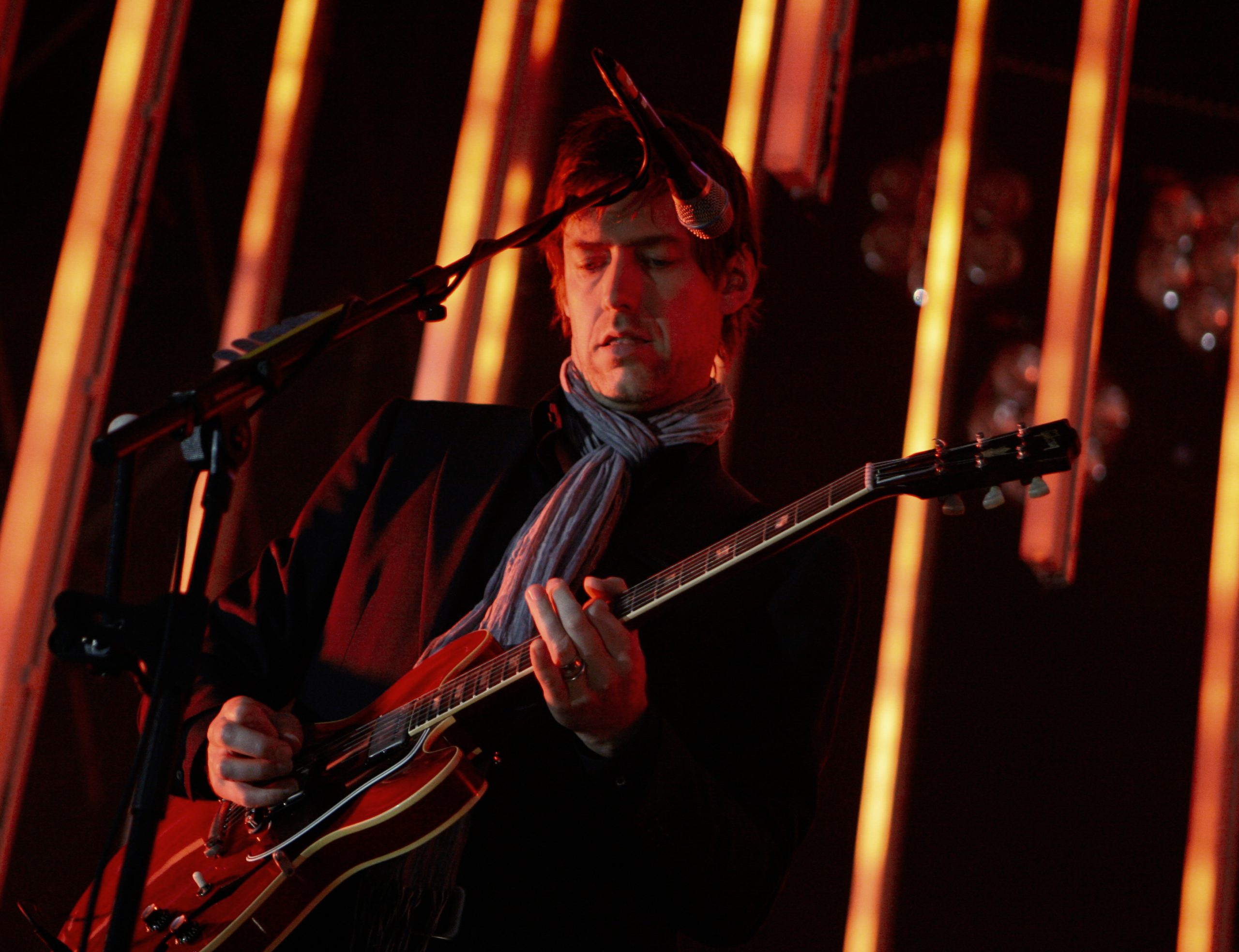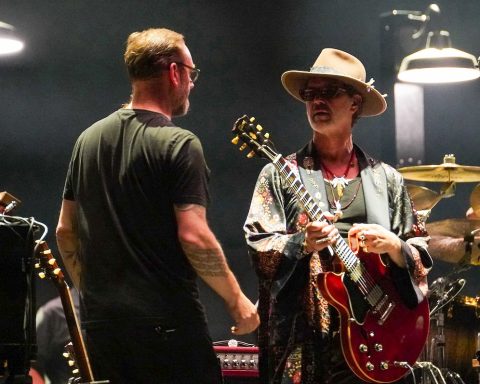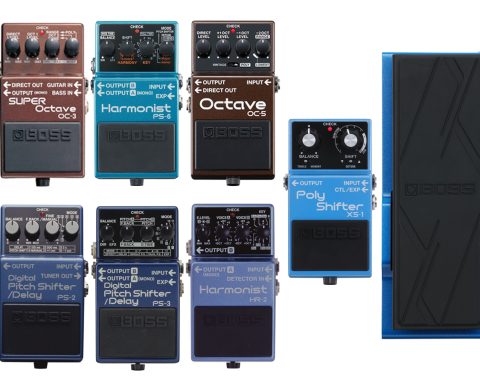Best known as the guitarist in Radiohead, Ed O’Brien’s ethereal washes of echo and delay-laden hooks helped define the sound of one of the most progressive and influential bands in music history. He’s also used BOSS pedals throughout his entire career. Find out how O’Brien differentiates eras of delay, how producer Flood surprised him in the studio, and how BOSS pedals form an emotional connection.
Vintage Appeal
Inspired by hearing a BOSS Micro Rack digital delay unit at an early band rehearsal, O’Brien purchased his first compact pedal: a DD-3 Digital Delay. With vintage digital appeal in spades (“slightly cleaner than an analog delay, but still has lots of character”), the DD-3 remains one of his go-to stompboxes. In fact, the tap tempo-equipped DD-3T features on O’Brien’s current pedalboard built by That Pedal Show’s Dan Steinhardt.
Released in 1986 and 1995, respectively, O’Brien describes the DD-3 as “the sound of the ’80s” and the DD-5 as “the sound of the ’90s.” Key to his world-famous trademark tones, the DD-5 Digital Delay was used by O’Brien almost exclusively to achieve the otherworldly guitar effects heard on Radiohead’s breakthrough albums The Bends and OK Computer. The DD-5 has remained on every Radiohead pedalboard since the ’90s; such is his enduring fondness for the discontinued BOSS classic.
Delay Reactions
O’Brien is also a big fan of the new BOSS family members, the DM-101 Delay Machine and SDE-3000D Dual Digital Delay. Loaded with eight CPU-controlled BBDs, the DM-101 takes vintage-style analog delay into the modern era with 12 programmable mono and stereo modes, plus extended features including modulation, tap tempo, MIDI control, and more. O’Brien considers it an “astonishing” design. “The beauty of the Delay Machine is you can instantly recall the analog delay sounds you’ve already dialed in,” he explains. “If you need to access sixty or seventy song settings, you can’t be down on the floor for them. I’ll do that in the studio, but it’s a different story on stage.”
"The beauty of the Delay Machine is you can instantly recall the analog delay sounds you’ve already dialed in."
In keeping with this ethos, a rich delay palette informed O’Brien’s last solo release, 2020’s acclaimed Earth. “On my new record, I used a Space Echo,” he reveals, “and I’ve got a stereo Space Echo built by Soundgas that gave me a sound I was seeking in my head.”
Similarly, the SDE-3000D recreates the 1980s vintage magic of Roland’s legendary SDE-3000 Digital Delay rack unit. “That ’80s era of delays was really special, and BOSS nailed it,” O’Brien enthuses. The echo aficionado has a broad palette of sonic colors at his disposal, utilizing a plethora of delay devices old and new. “Each has its own sound,” Ed tells us. “I often think of sound as color; if you’re a painter, delays are your blues. So, it’s like different shades of blue—dark blue, light blue, sky blue.”

Plethora of Pedals
While O’Brien’s masterful delay sounds have graced Radiohead records and concerts throughout the decades, numerous other BOSS pedals have also made their way into the guitarist’s rig. “We always used the BOSS tuners,” he recalls. “And the RV-5 Reverb—oh my god! Jonny had one of those, I had one, and I think Thom also had one,” he says of his Radiohead bandmates. “I used the TR-2 Tremolo—absolutely brilliant—and I’ve got a BOSS Flanger, which is amazing.”
He goes on to praise a limited edition high-profile BOSS collab and other favorites. “I like the Tone Bender BOSS did with Macari’s, and the OD-1. That pedal is great into an amp that’s already starting to distort. I bought an original CE-1 from Soundgas several years ago, and the preamp is unbelievable.”
A Flood of Ideas
Super-producer Flood (U2, NIN, Depeche Mode) shares the love for the CE-1. “When I was working with Flood, he said, ‘We’re going to put this CE-1 on the bass,’” O’Brien recalls. “I said, ‘No, we’re not putting chorus on the bass!’ He told me, ‘We’re not using it for chorus.’ The classic studio trick with the CE-1 preamp really adds some magic.”
“Another big part of my sound was the LS-2 Line Selector pedal,” he says. “I did an early version of a wet and dry setup. Nobody really did line-switching pedals in the mid-’90s.” The pedal afforded O’Brien many sonic opportunities, particularly onstage. “What was revelatory for me was not just A or B, but A plus B, where you could suddenly combine sounds. I used that quite a lot live for technicolor moments in the Radiohead set.”
"What was revelatory for me was not just A or B, but A plus B, where you could suddenly combine sounds. I used that for technicolor moments in the Radiohead set."
Mutual Admiration
Now celebrating our 50th anniversary, BOSS is proud to help artists like O’Brien realize their unique musical vision. “BOSS has been at the forefront of all this incredible music,” O’Brien affirms. “I always thank people who create pedals because they inspire us as musicians and make us want to play.”
The feeling is mutual, and BOSS continues to embrace its tradition of innovation. Indeed, while revisiting vintage units, engineers strive to advance the designs to benefit players like O’Brien.
“I think what’s super smart is that BOSS are realizing their old pedals have the sound of certain eras, and they’re going back and looking at the classics,” O’Brien asserts. “They’ve got all these great models, and they’ve been bringing them back.”
Potential and Possibilities
The legendary BOSS aesthetic remains a draw for the guitarist. “They’re the coolest-looking pedals,” O’Brien confirms. “I’ve been lucky to meet a lot of boutique pedal designers and builders, and they often say that not only do BOSS pedals sound amazing, but they also look super cool. They’re completely iconic.”
His sentiments go deeper than just the design. “It’s funny talking about BOSS pedals because you realize there’s an emotional connection. I still get excited when I get a new BOSS pedal and open that box,” he says. “That snug-fitting box, and the color of it, still feels like Christmas Day.”
"It’s funny talking about BOSS pedals because you realize there’s an emotional connection."
Ultimately, the sense of exploration and adventure keeps O’Brien excited about effects pedals. “It’s about the potential—what lies ahead, the possibilities,” he explains. “You can get so many different sounds. I could go on a desert island with five BOSS pedals and be happy.”







